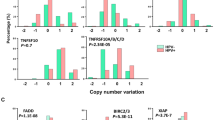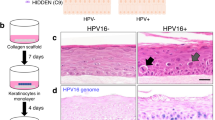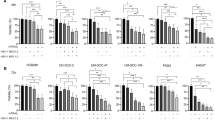Abstract
Interferon (IFN)-β induces S-phase slowing and apoptosis in human papilloma virus (HPV)-positive cervical carcinoma cell line ME-180. Here, we show that apoptosis is a consequence of the S-phase lengthening imposed by IFN-β, demonstrating the functional correlation between S-phase alteration and apoptosis induction. In ME-180 cells, where p53 function is inhibited by HPV E6 oncoprotein, IFN-β effects on cell cycle and apoptosis occur independently of p53. The apoptosis due to IFN-β is mediated by the tumor necrosis factor-related apoptosis-inducing ligand (TRAIL) in a manner dependent on the S-phase deregulation. IFN-β appears to increase TRAIL expression both directly at the mRNA level and indirectly by augmenting surface protein levels as a consequence of the induced S-phase cell accumulation. Moreover, the alteration of the S-phase due to IFN-β promotes TRAIL-dependent apoptosis by potentiating cell sensitivity to TRAIL, possibly through induction of a proapoptotic NF-κB activity and TRAIL-R2 receptor expression. Interestingly, IFN-β-induced TRAIL-dependent apoptotic events strongly differ in the requirement of caspase activity. These results show that IFN-β may induce an apoptotic response by deregulating cell cycle. Understanding the linkage between these mechanisms appears to be of primary importance in the search for new IFN-based therapeutic strategies to circumvent cancer disease or improve clinical outcome.
This is a preview of subscription content, access via your institution
Access options
Subscribe to this journal
Receive 50 print issues and online access
$259.00 per year
only $5.18 per issue
Buy this article
- Purchase on SpringerLink
- Instant access to full article PDF
Prices may be subject to local taxes which are calculated during checkout






Similar content being viewed by others
References
Armitage RJ . (1994). Curr. Opin. Immunol., 6, 407–413.
Ashkenazi A, Pai RC, Fong S, Leung S, Lawrence DA, Marsters SA, Blackie C, Chang L, McMurtrey AE, Hebert A, DeForge L, Koumenis IL, Lewis D, Harris L, Bussiere J, Koeppen H, Shahrokh Z and Schwall RH . (1999). J. Clin. Invest., 104, 155–162.
Baetu TM and Hiscott J . (2002). Cytokine Growth Factor Rev., 13, 199–207.
Baetu TM, Kwon H, Sharma S, Grandvaux N and Hiscott J . (2001). Immunology, 167, 3164–3173.
Blandino G, Levine AJ and Oren M . (1999). Oncogene, 18, 477–485.
Borden EC, Lindner D, Dreicer R, Hussein M and Peereboom D . (2000). Semin. Cancer Biol., 10, 125–144.
Chawla-Sarkar M, Leaman DW and Borden EC . (2001). Cancer Res., 7, 1821–1831.
Chawla-Sarkar M, Leaman DW, Jacobs BS and Borden EC . (2002). J. Immunol., 169, 847–855.
Chen C, Edelstein LC and Gelinas C . (2000). Mol. Cell. Biol., 20, 2687–2695.
Chen Q, Gong B, Mahmoud-Ahmed AS, Zhou A, His ED, Hussein M and Almasan A . (2001). Blood, 98, 2183–2192.
Choi EA, Lei H, Maron DJ, Wilson JM, Barsoum J, Fraker DL, El-Deiry WS and Spitz FR . (2003). Cancer Res., 63, 5299–5307.
El-Deiry WS . (2001). Cell Death Differ., 8, 1066–1075.
Fanger NA, Maliszewski CR, Schooley K and Griffith TS . (1999). J. Exp. Med., 190, 1155–1164.
Fiorucci G, Vannucchi S, Chiantore MV, Percario ZA, Affabris E and Romeo G . (2005). Curr. Pharm. Des., 10 (in press).
Fogal V, Gostissa M, Sandy P, Zacchi P, Sternsdorf T, Jensen K, Pandolfi PP, Will H, Schneider C and Del Sal G . (2000). EMBO J., 19, 6185–6195.
Ghosh SK, Wood C, Boise LH, Mian AM, Deyev VV, Feuer G, Toomey NL, Shank NC, Cabral L, Barber GN and Harrington Jr WJ . (2003). Blood, 101, 2321–2327.
Giandomenico V, Vaccari G, Fiorucci G, Percario Z, Matarrese P, Malorni W, Romeo G and Affabris E . (1998). Eur. Cytokine Network, 9, 613–631.
Gibson SB, Oyer R, Spalding AC, Anderson SM and Johnson GL . (2000). Mol. Cell. Biol., 20, 205–212.
Gong B and Almasan A . (2000). Biochem. Biophys. Res. Commun., 278, 747–752.
Gross A, Yin XM, Wang K, Wei MC, Jockel J, Milliman C, Erdjument-Bromage H, Tempst P and Korsmeyer SJ . (1999). J. Biol. Chem., 274, 1156–1163.
Hu WH, Johnson H and Shu HB . (1999). J. Biol. Chem., 274, 30603–30610.
Kayagaki N, Yamaguchi N, Nakayama M, Eto H, Okumura K and Yagita H . (1999). J. Exp. Med., 189, 1451–1460.
Meng RD and El-Deiry WS . (2001). Exp. Cell Res., 262, 154–169.
Muhlenbeck F, Schneider P, Bodmer JL, Schwenzer R, Hauser A, Schubert G, Scheurich P, Moosmayer D, Tschopp J and Wajant H . (2000). J. Biol. Chem., 275, 32208–32213.
Oshima K, Yanase N, Ibukiyama C, Yamashina A, Kayagaki N, Yagita H and Mizuguchi J . (2001). Cytokine, 14, 193–201.
Percario ZA, Giandomenico V, Fiorucci G, Chiantore MV, Vannucchi S, Hiscott J, Affabris E and Romeo G . (1999). Cell Growth Differ., 10, 263–270.
Pucci B, Kasten M and Giordano A . (2000). Neoplasia, 2, 291–299.
Sato K, Hida S, Takayanagi H, Yokochi T, Kayagaki N, Takeda K, Yagita H, Okumura K, Tanaka N, Taniguchi T and Ogasawara K . (2001). Eur. J. Immunol., 31, 3138–3146.
Scaffidi C, Fulda S, Srinivasan A, Friesen C, Li F, Tomaselli KJ, Debatin KM, Krammer PH and Peter ME . (1998). EMBO J., 17, 1675–1687.
Sedger LM, Shows DM, Blanton RA, Peschon JJ, Goodwin RG, Cosman D and Wiley SR . (1999). J. Immunol., 163, 920–926.
Sheikh MS, Burns TF, Huang Y, Wu GS, Amundson S, Brooks KS, Fornace Jr AJ and El-Deiry WS . (1998). Cancer Res., 58, 1593–1598.
Shetty S, Gladden JB, Henson ES, Hu X, Villanueva J, Haney N and Gibson SB . (2002). Apoptosis, 7, 413–420.
Shigeno M, Nakao K, Ichikawa T, Suzuki K, Kawakami A, Abiru S, Miyazoe S, Nakagawa Y, Ishikawa H, Hamasaki K, Nakata K, Ishii N and Eguchi K . (2003). Oncogene, 22, 1653–1662.
Shin E-C, Seong YR, Kim CH, Kim H, Ahn YS, Kim K, Kim SJ, Hong S-S and Park JH . (2002). Exp. Mol. Med., 34, 114–122.
Stennicke HR, Jurgensmeier JM, Shin H, Deveraux Q, Wolf BB, Yang X, Zhou Q, Ellerby HM, Ellerby LM, Bredesen D, Green DR, Reed JC, Froelich CJ and Salvesen GS . (1998). J. Biol. Chem., 273, 27084–27090.
Toomey NL, Deyev VV, Wood C, Boise LH, Scott D, Liu LH, Cabral L, Podack ER, Barber GN and Harrington Jr WJ . (2001). Oncogene, 20, 7029–7040.
Vannucchi S, Precario ZA, Chiantore MV, Matarrese P, Chelbi-Alix MK, Fagioli M, Pelicci PG, Malori W, Fiorucci G, Romeo G and Affabris E . (2000). Oncogene, 9, 5041–5053.
Wang CY, Mayo MW, Korneluk R, Goeddel DV and Baldwin Jr AS . (1998). Science, 281, 1680–1683.
Wang Q, Ji Y, Wang X and Evers BM . (2000). Biochem. Biophys. Res. Commun., 276, 466–471.
Wilson CA and Browning JL . (2002). Cell Death Differ., 9, 1321–1333.
Younes A and Kadin ME . (2003). J. Clin. Oncol., 21, 3526–3534.
Acknowledgements
We thank G Blandino, C Gaetano and B Vogelstein for providing the reagents used in this study. We are grateful to Paolo Piccinini, Sabrina Tocchio and Roberto Gilardi for excellent editorial assistance. We also thank Simonetta Rasi for technical help. This work was supported by CNR Agenzia 2000 CNRC008B98_004, Ministero della Salute Progetto Strategico 2002 and Progetti Nazionali MIUR 2002.
Author information
Authors and Affiliations
Corresponding author
Rights and permissions
About this article
Cite this article
Vannucchi, S., Chiantore, M., Fiorucci, G. et al. TRAIL is a key target in S-phase slowing-dependent apoptosis induced by interferon-β in cervical carcinoma cells. Oncogene 24, 2536–2546 (2005). https://doi.org/10.1038/sj.onc.1208403
Received:
Revised:
Accepted:
Published:
Issue date:
DOI: https://doi.org/10.1038/sj.onc.1208403
Keywords
This article is cited by
-
Prediction of signaling cross-talks contributing to acquired drug resistance in breast cancer cells by Bayesian statistical modeling
BMC Systems Biology (2015)
-
Nip the HPV encoded evil in the cancer bud: HPV reshapes TRAILs and signaling landscapes
Cancer Cell International (2013)



